iPhone 8
Apple's iPhone 8 is coming in the fall of 2017.

AT A GLANCE
- Apple has a major iPhone redesign planned for 2017, with a glass body and edge-to-edge OLED display that does away with the Home button and perhaps replaces Touch ID with a new facial recognition system. The new iPhone may be sold alongside upgraded (but standard) 4.7 and 5.5-inch iPhones.
EXPECTED FEATURES
- 5.8" OLED display
- Faster A11 processor
- Glass body
- Edge-to-edge display
- Facial Recognition, perhaps replacing Touch ID
- No Home button
- Wireless charging
- Three models - One OLED, two standard
Apple's iPhone 8 - Coming in 2017
CONTENTS
2017 will mark the 10th anniversary of the iPhone and Apple has something major planned to celebrate the occasion. We've got several months to go until the launch of the iPhone 8, but because of Apple's ambitious plans for the device, there are already an abundance of rumors hinting at the impressive features coming in the 2017 iPhone.
Apple is rumored to be testing more than 10 prototype iPhone models, so it's not entirely clear what we're going to see, and because there are so many test devices in play, rumors are also conflicting and murky at this time.
Rumors suggest the iPhone 8 will feature a radical redesign, with an edge-to-edge display that does away with the top and bottom bezels where features like the Touch ID fingerprint sensor and the front-facing camera are housed. Instead, rumors suggest Touch ID will either be built into the display or eliminated entirely in favor of facial recognition technology. Either way, there will be no physical Home button on the iPhone 8 and no bezels aside from a small area for the front-facing camera.
With an edge-to-edge design, the iPhone 8 may be similar in size to the 4.7-inch iPhone, but with a display the size of the 5.5-inch iPhone. Rumors suggest it will feature a 5.8-inch display with 5.15 inches of usable area, with the rest dedicated to virtual buttons that will replace the existing Home button.
The display itself is said to be flexible plastic OLED rather than an LCD, allowing Apple to introduce a thinner device that consumes less power and offers a better display with higher contrast ratio and more true to life colors. It will feature a slightly curved 2.5D display that's similar to the display used in the iPhone 7.
As for the body, rumors suggest Apple is finally moving away from the aluminum used in the iPhone 5, 5s, 6, 6s, 7, and SE, and will instead adopt a glass body that's similar to the body that was used in the iPhone 4. At least one iPhone model coming in 2017 will use a glass body, according to Apple supplier Catcher Technology, and according to analyst Ming-Chi Kuo, the glass will be built around a polished stainless steel frame that's similar in design to the Apple Watch.

Like the iPhone 7, the iPhone 8 is expected to be water resistant, but it may have an improved IP68 water resistance rating. It will continue to be able to hold up to rain, splashes, and brief submersion in water, and that water resistance has been confirmed by an Apple supplier and may extend to all iPhone models being released in 2017.
Inside, the iPhone 8 is expected to have a 10-nanometer A11 chip that will be both faster and more efficient, plus rumors suggest it could also include features like induction-based wireless charging and biometric additions like facial recognition that would be used for device security, perhaps to replace Touch ID. In higher-end models with a dual-lens camera, both lenses are expected to feature optical image stabilization.
The iPhone 8's front-facing camera will include advanced 3D sensing capabilities that use technology by PrimeSense, allowing it to find the location and depth of objects in front of it, enabling facial and iris recognition. Rumors suggest Apple will use a vertical rear camera for improved pictures and better AR functionality, along with a dual-camera setup for the front-facing FaceTime camera.
Apple is said to be planning to position the OLED iPhone 8 as a ~5-inch "premium" model that will be sold alongside standard 4.7 and 5.5-inch iPhone models with traditional LCD screens. To mark its status as an elite model, the iPhone 8 may be available in a limited number of colors. The iPhone 8 is expected to cost as much as $1,000, which is a good deal more expensive than previous iPhones.

Given the radical design changes Apple plans to introduce in the OLED iPhone, rumors have been suggesting there will be serious supply constraints. Apple may introduce the ~5-inch OLED iPhone at a September event alongside the standard 4.7 and 5.5-inch devices, but there's a chance it won't be released until one or two months after its introduction. Alternatively, it may be available in small numbers, with the majority of people unable to get their hands on it until the first quarter of 2018.
Schematics, Design Leaks, and Cases
Early iPhone 8 design schematics started surfacing in April, but the leaks haven't entirely cleared up questions about what we can expect from the device. We're seeing at least two distinct designs depicted in current leaked schematics and renderings because Apple is said to be testing multiple iPhone 8 prototypes. With early leaks, it's often difficult to tell what's accurate, so take the below information with a grain of salt until part leaks and other more reliable information starts to surface.
PROTOTYPE 1:
The first design we're seeing appears to have an edge-to-edge display, a glass body, and no visible Touch ID button anywhere on the device, pointing towards an iPhone 8 with Touch ID located under the display or no Touch ID functionality at all. This is the design that matches up with many of the rumors that we've heard about the iPhone 8.
An alleged rendering featuring that first design, pictured below, depicts a device that measures 137.54mm tall by 67.54mm wide, similar in size to the iPhone 7. Thickness is not shown, but there's a nearly edge-to-edge display that measures 5.767 inches on the diagonal. A 4mm bezel is pictured around the display, with half of that being the 2.5D curved glass at the edges. All of this is in line with rumors suggesting an iPhone 7-sized device with an iPhone 7 Plus-sized display.
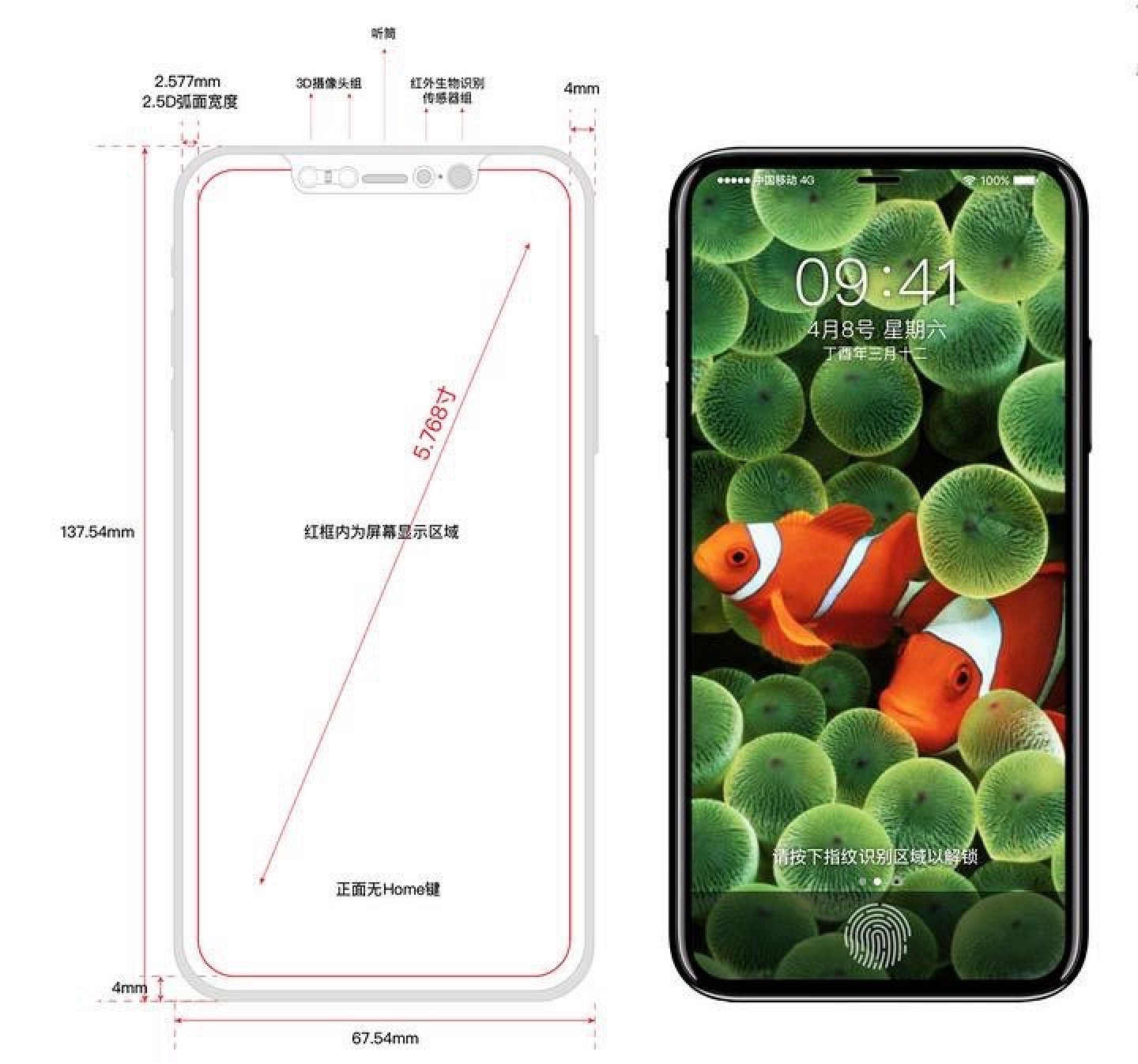
A narrow earpiece is depicted on the front of the device alongside cameras and sensors that appear to be embedded in the display area. There is no Home button and no visible Touch ID sensor.
An image of what's said to be an iPhone 8 CNC dummy model sourced from Foxconn surfaced in late April, and it features a prototype 1 design with front and rear panels made from slightly curved 2.5D glass held together with a stainless steel frame. Those steel edges will reportedly be finished a polished "Space Black" color in at least one of the devices.
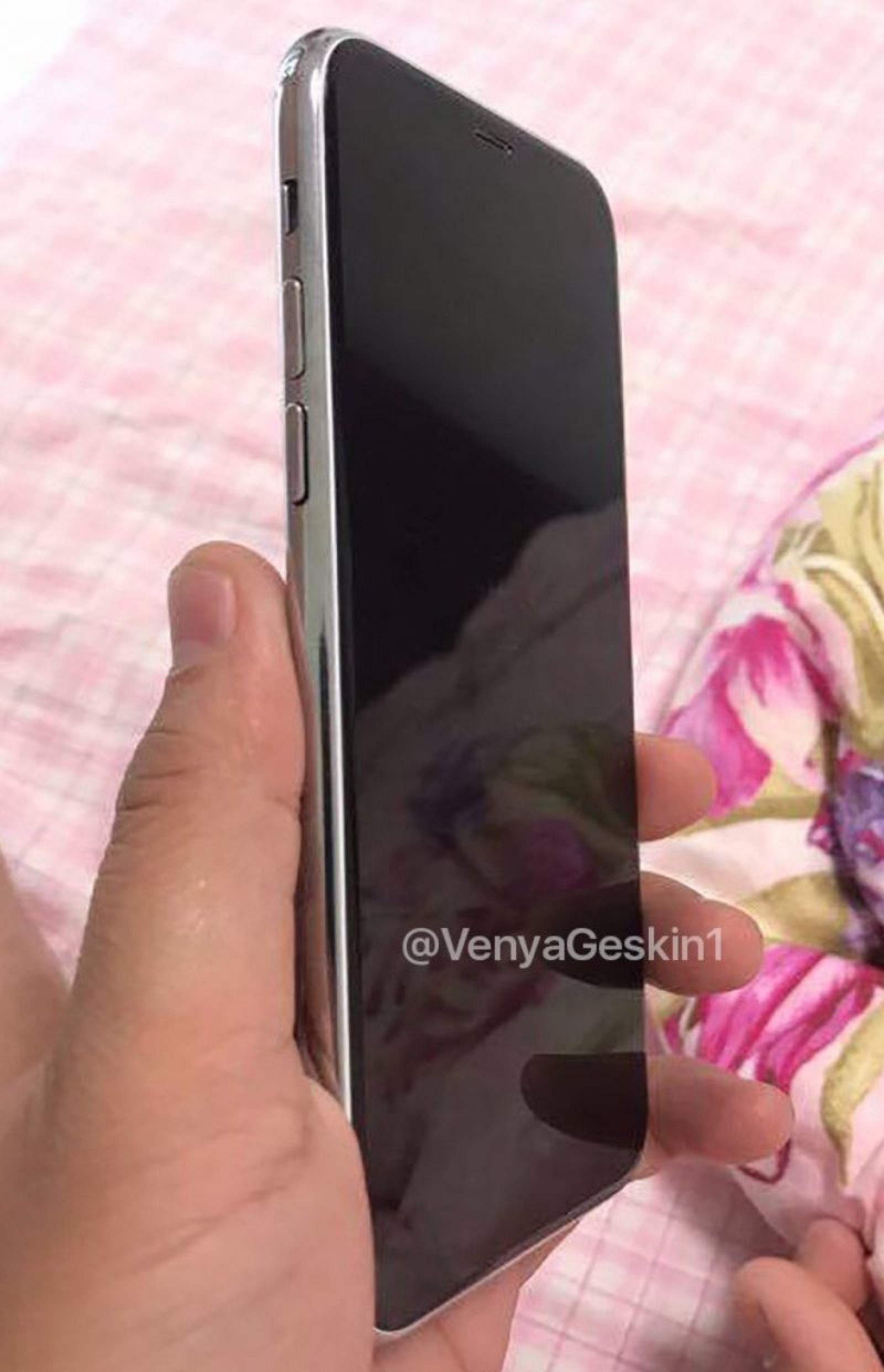
The dummy iPhone 8 appears to be thicker than existing iPhone models, but it features an edge-to-edge screen with no Home button. At the rear of the device, there's a vertical dual-lens camera with no other markings. There is no rear Touch ID sensor nor an Apple logo.
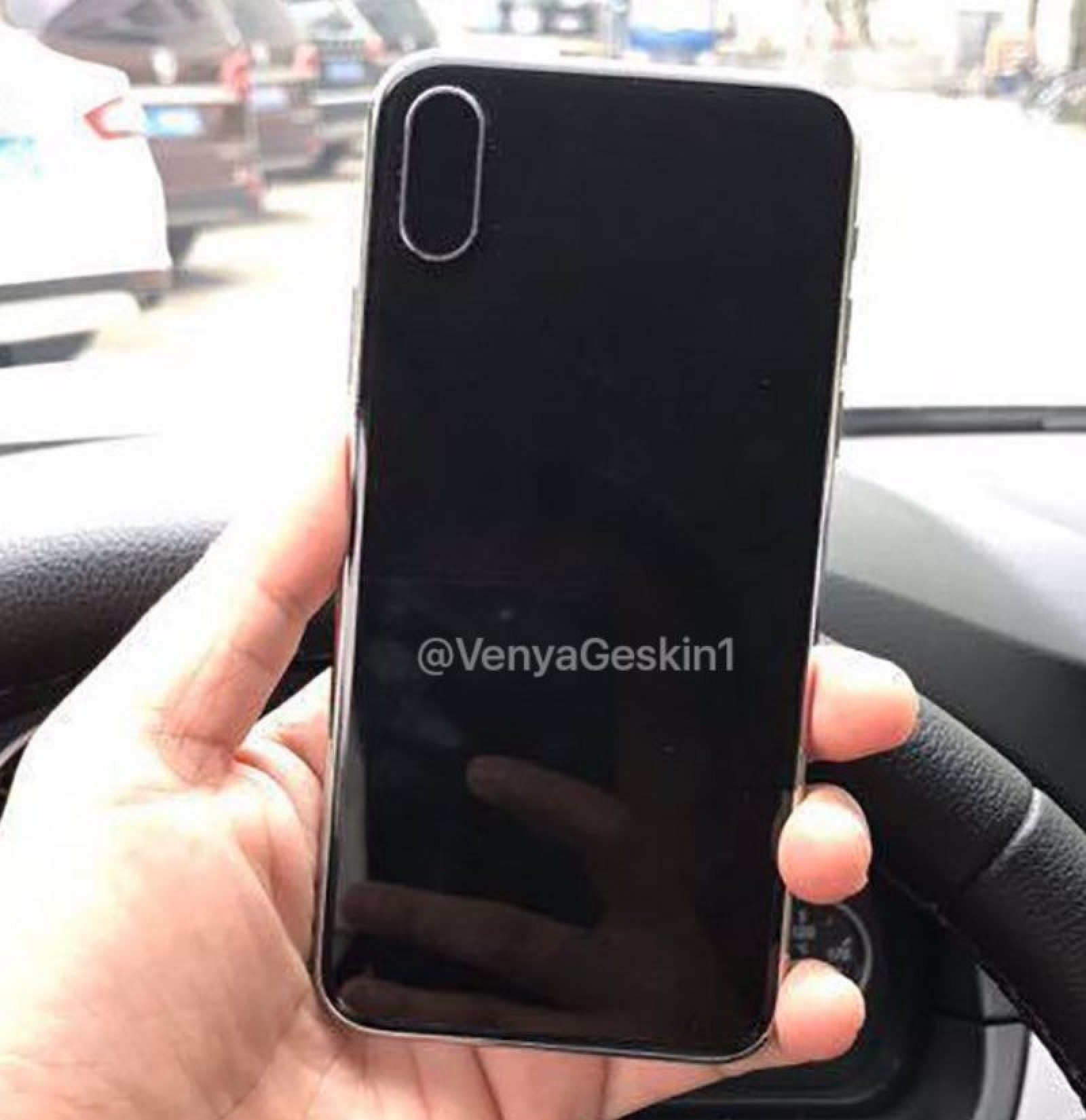
At the sides, there are volume buttons and a mute switch on the left, with an elongated power button and a SIM tray on the right. The video below offers up a detailed look at the dummy model, which could perhaps be representative of what the iPhone 8 will look like.
Dummy models are often constructed by case makers and other accessory manufacturers based on rumors and leaks coming out of the supply chain. Case makers use dummy models to create cases ahead of an iPhone's launch to be first on the market with accessories. In past years, these dummy models have been largely accurate, but there are, on occasion, design discrepancies.
We've also seen prototype 1 schematics "based on blueprints" that allegedly give a look at the sensors located under the display and inside the device. At the top of the device, there's an embedded camera, flash, and ambient light sensors.
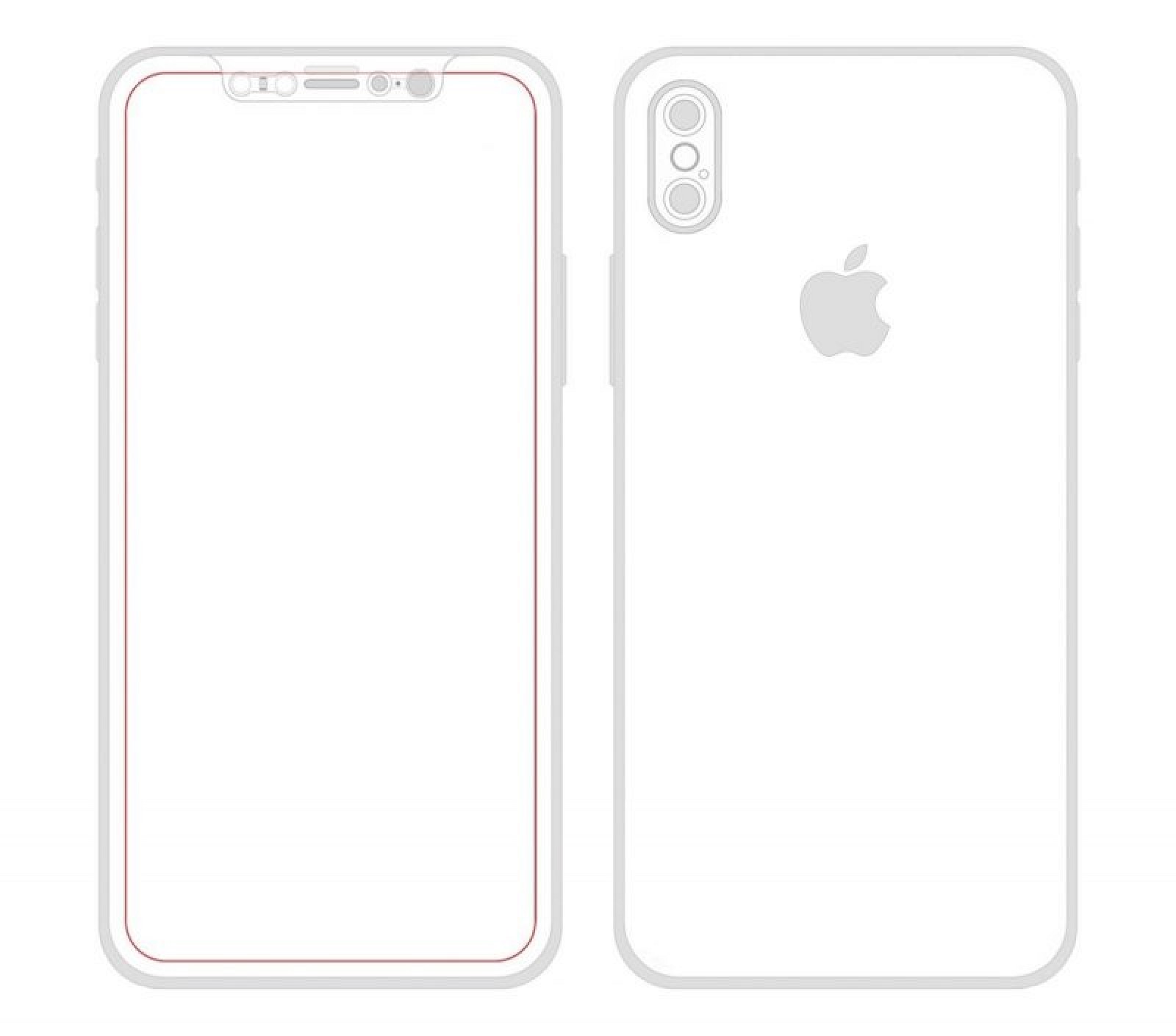
An alleged rear shell schematic, which may or may not be legitimate, depicts a vertical dual-lens rear camera with an LED flash in the middle, and it includes a large circular area, perhaps for some kind of wireless charging functionality. No rear Touch ID button is pictured.
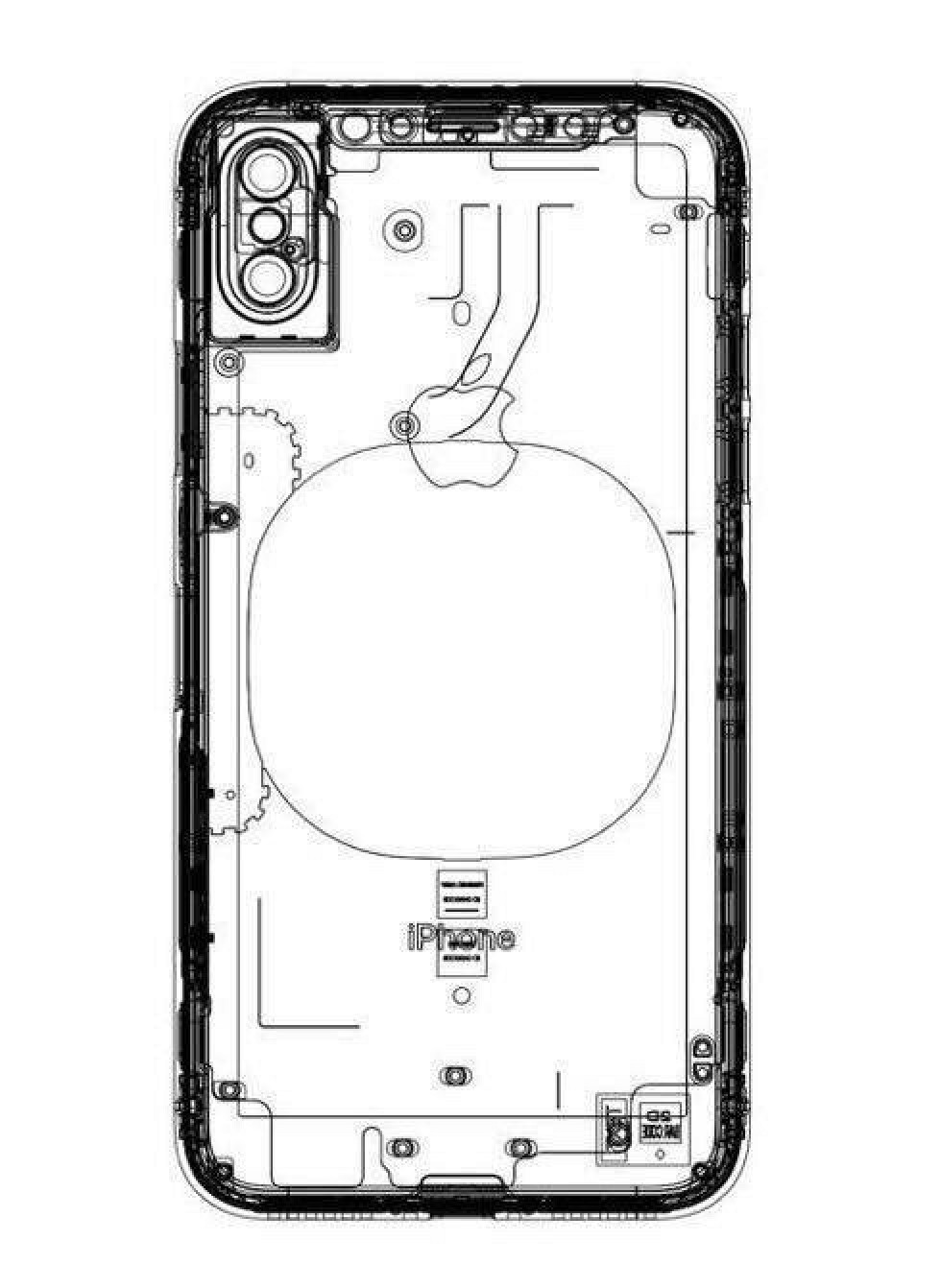
Our first glimpse of components that could be destined for the iPhone 8 surfaced in mid-June. The images, said to be sourced from a case manufacturer who received them from a glass supplier in China, depict what is said to be the front and bank panel of the iPhone 8.
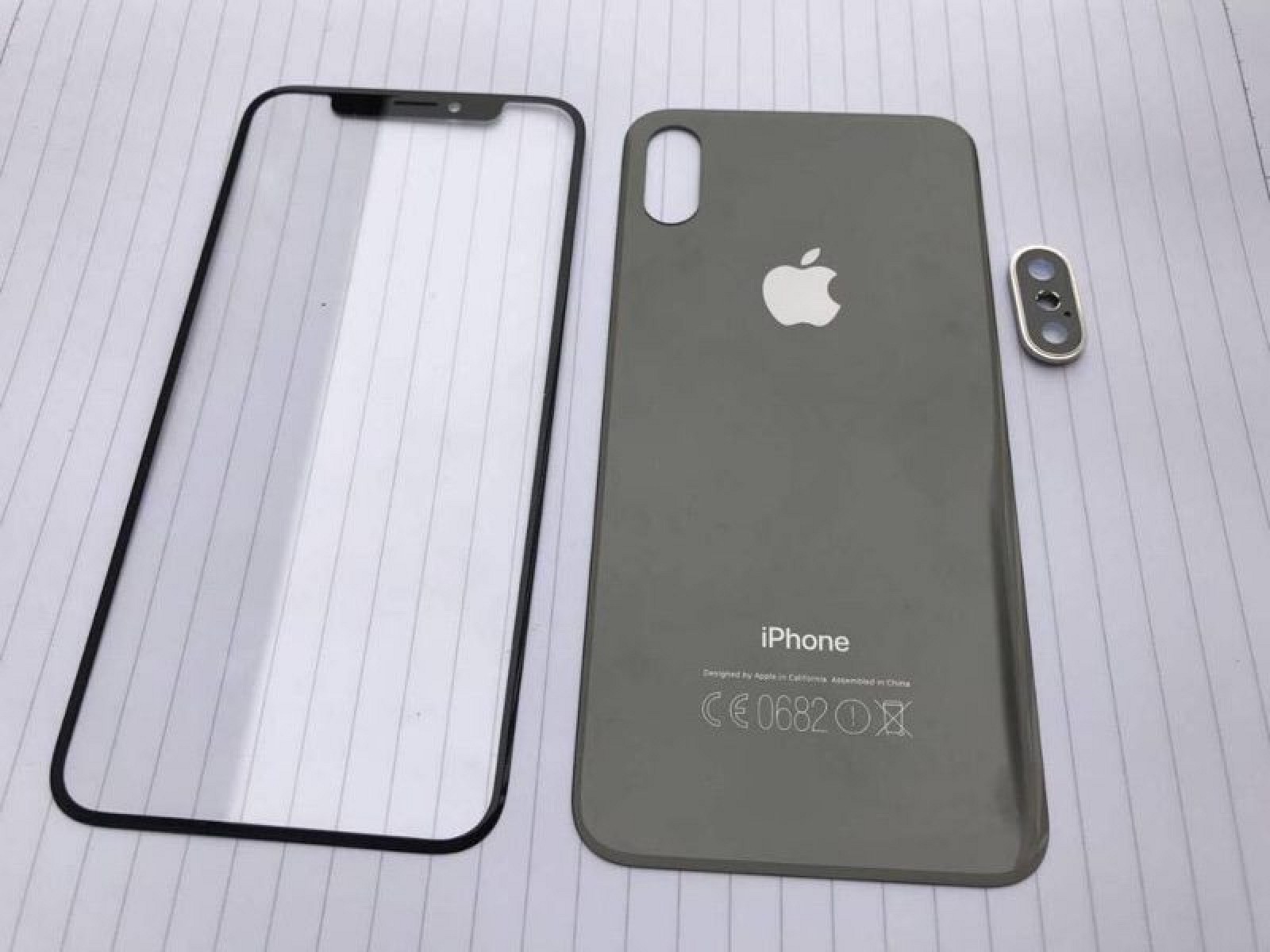
There's a thin bezel around the sides along with a top bar that could perhaps house a front-facing camera, microphone, and speaker. Notably, there's no cutout for a Touch ID fingerprint sensor, which is in line with the rumors that suggest Apple will embed it in the display or eliminate it.
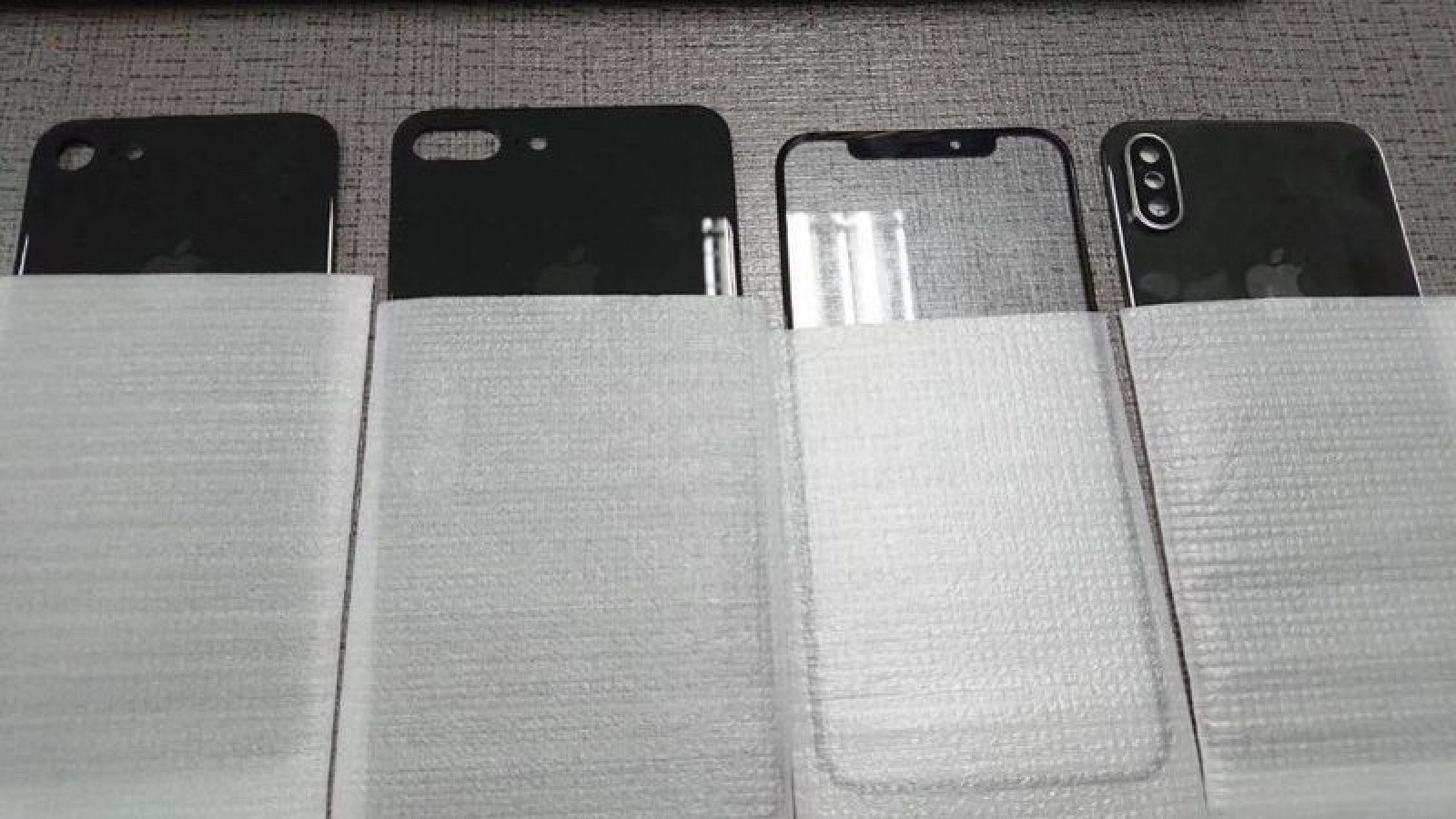
A second photo depicts the two alleged iPhone 8 components next to components said to be for the 4.7-inch iPhone 7s and the 5.5-inch iPhone 7s Plus. All three rear shells are made from glass to support wireless charging. There's no way to verify the authenticity of the components in the images, so they should be viewed with caution until we get additional part leaks.
An iPhone case said to be for the iPhone 8 has leaked, showing off a design that's similar to many of the prototype 1 renderings. It features a cutout for a vertical dual-lens rear camera and because it has no cutout for Touch ID or other features, it suggests it is for a device with no rear-facing Touch ID button.
It continues to have pill-shaped volume buttons, but there is a longer power button located on the left, something we've also seen in renderings and other desk leaks.
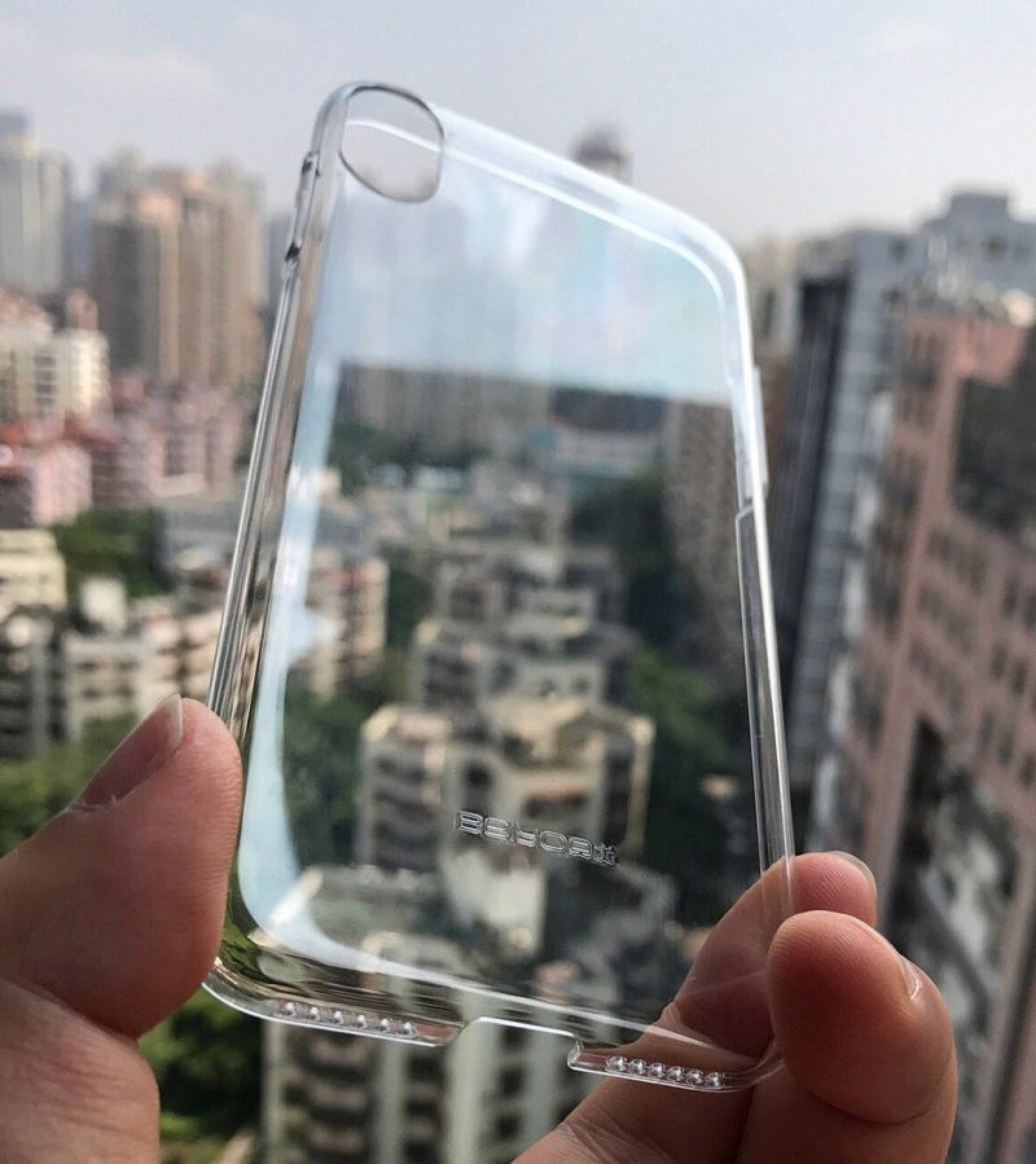
If legitimate, photos that allegedly show molds of the upcoming 2017 ~5-inch OLED iPhone, 4.7-inch iPhone, and 5.5-inch offer a look at the size differences between the devices. The 5.5-inch iPhone continues to be much larger, while the OLED iPhone, which is rumored to have a 5.8-inch display, is similar in size to the 4.7-inch iPhone because it has no display bezels.
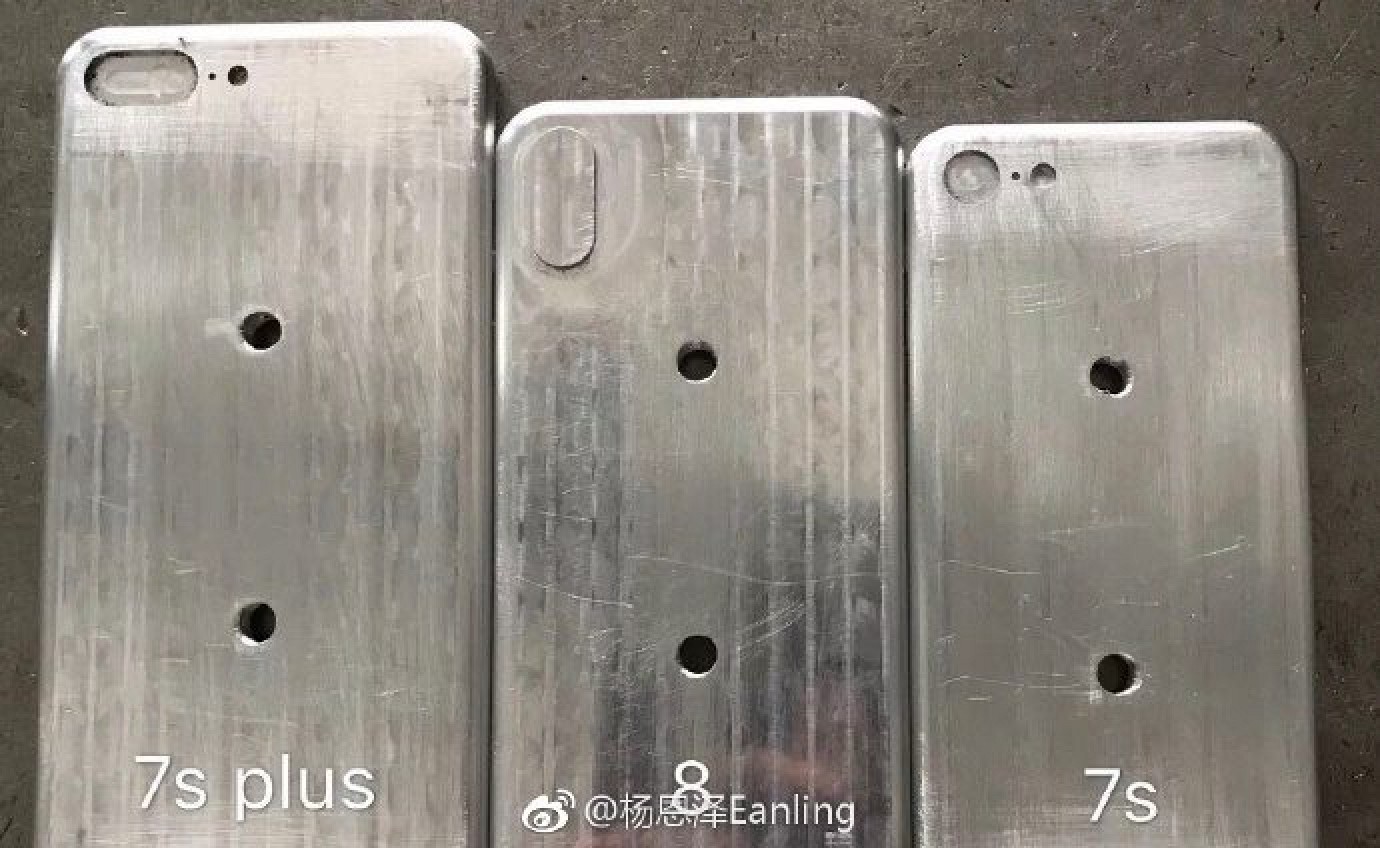
The 5.8-inch iPhone mold has a vertical camera and a longer power button, two features that have been seen in previous leaks. It's not clear if these are molds for the iPhone or for molds that are used for things like third-party cases, but the sizes do appear to match up with rumors we've been hearing about the devices.
Japanese site Mac Otakara found an iPhone 8 case on Alibaba, and used it to make some size comparisons to the iPhone 7 and the iPhone 7 Plus. The iPhone case in question is similar in design to many of the leaked prototype 1 design drawings and dummy models that that have been seen, and it could potentially be representative of the final design of the iPhone 8.
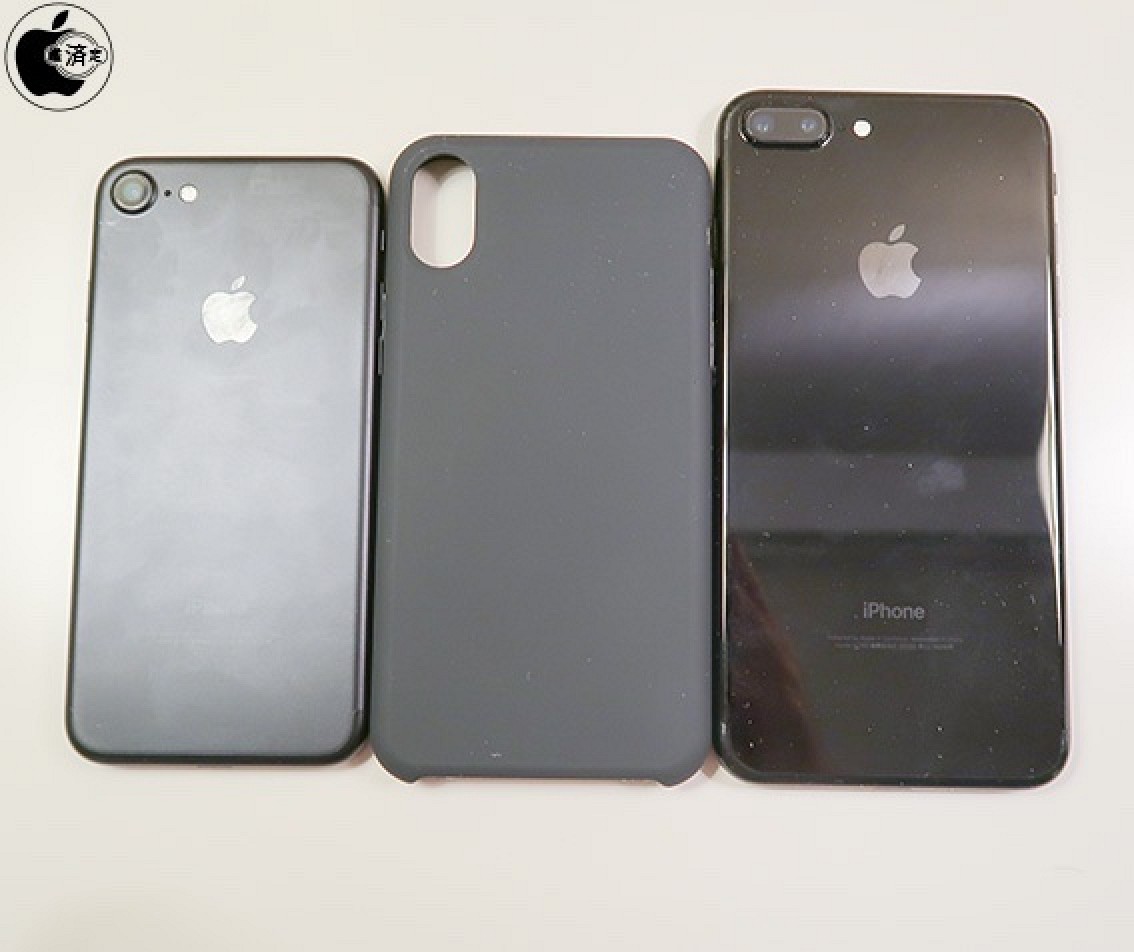
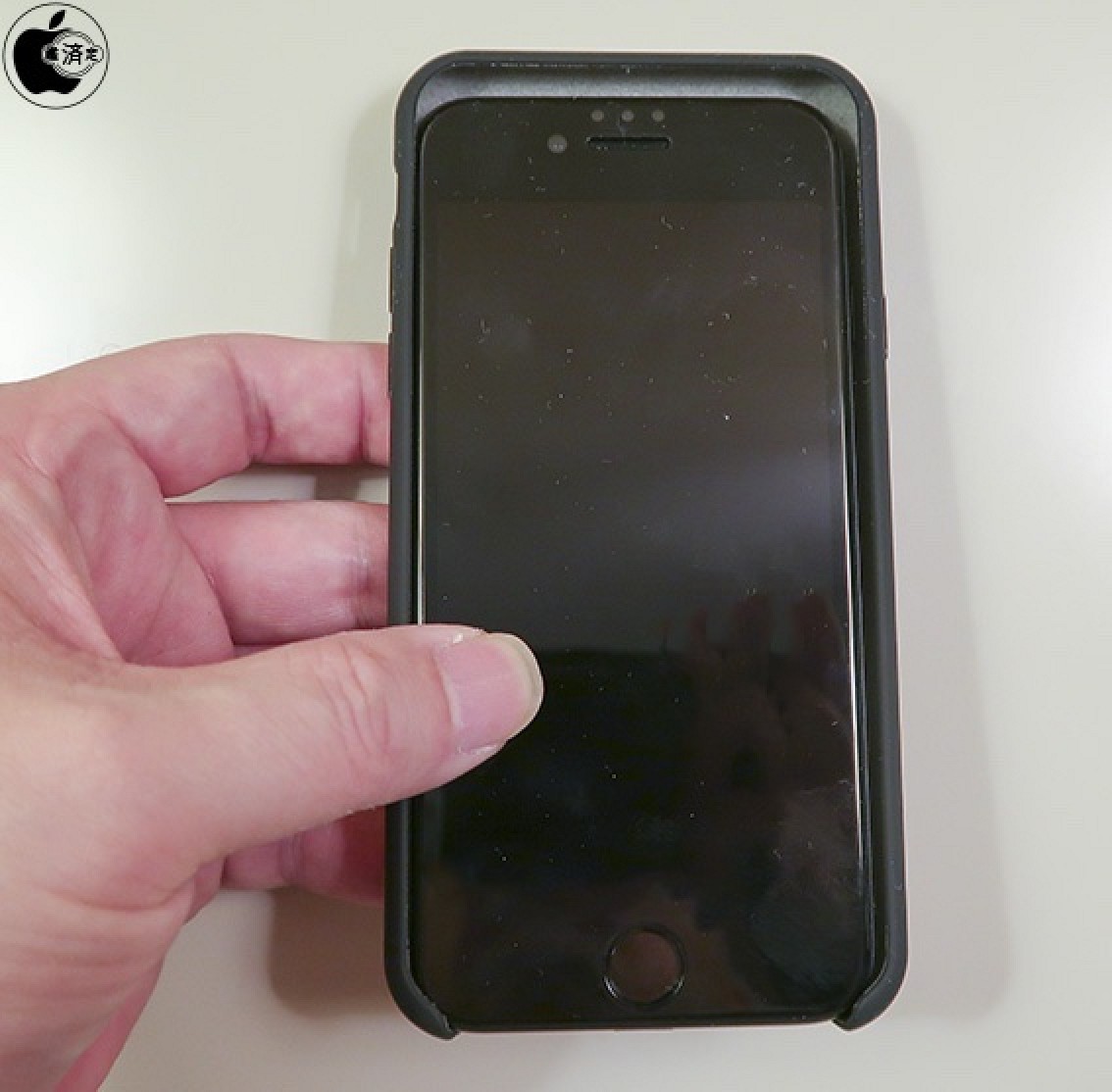
An iPhone 7 placed inside the case suggests the iPhone 8 will be just a bit wider than the iPhone 7, but quite a bit taller. The iPhone 7 is "loose" in the case, as the iPhone 8 is also expected to be thicker.
iPhone 8 renders based on a device that's 144mm tall, 71mm wide, and 7.7mm thick were compared to the iPhone 7 and the iPhone 7 Plus, giving us another look at how the iPhone 8 fits into the iPhone lineup.
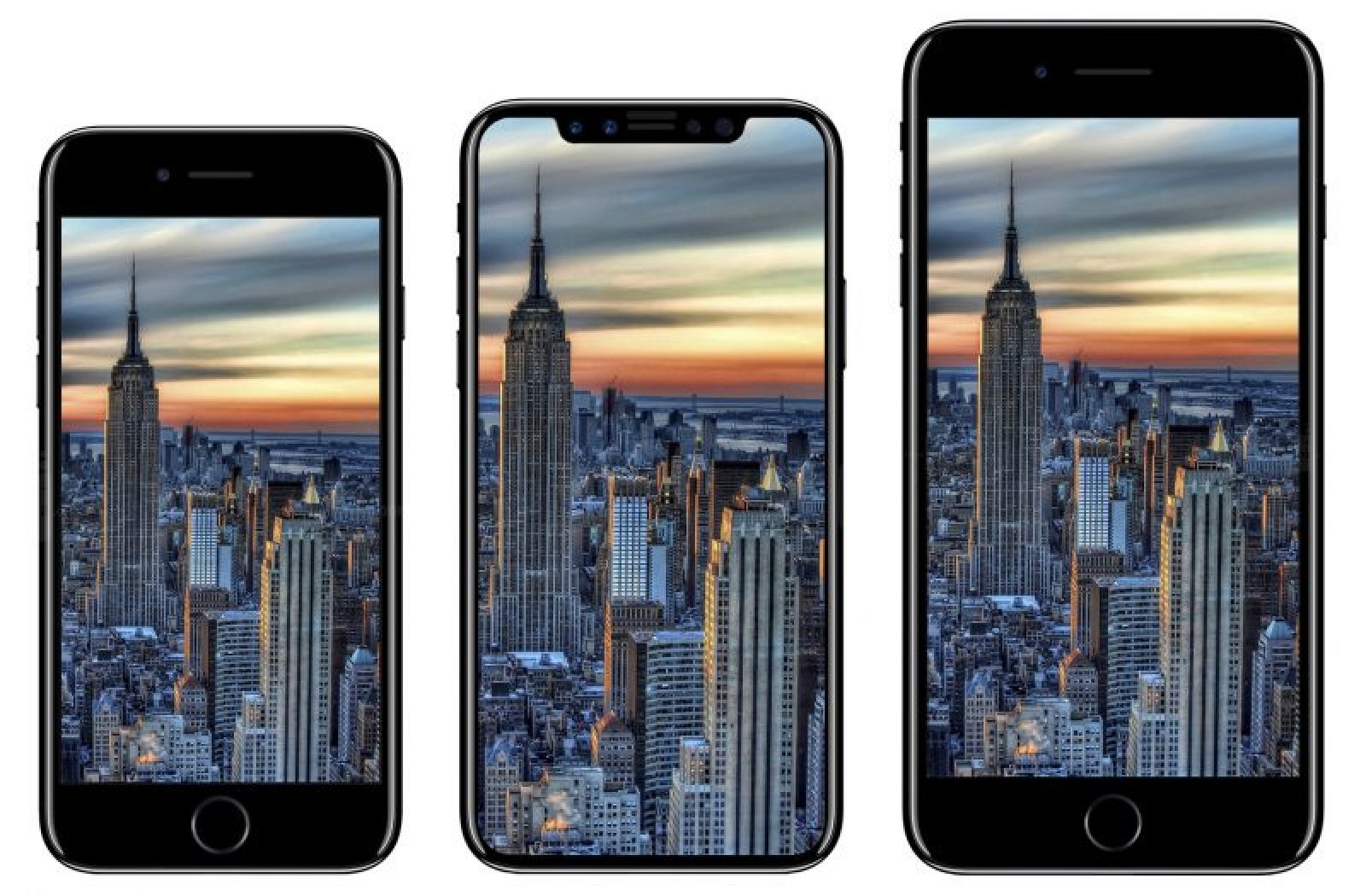
The iPhone 8, if the measurement predictions are accurate, is wider, thicker, and taller than the iPhone 7, but not as large as the iPhone 7 Plus.
A screen protector said to be designed for the iPhone 8 is in line with many of the display rumors, renderings, and part leaks we've seen.
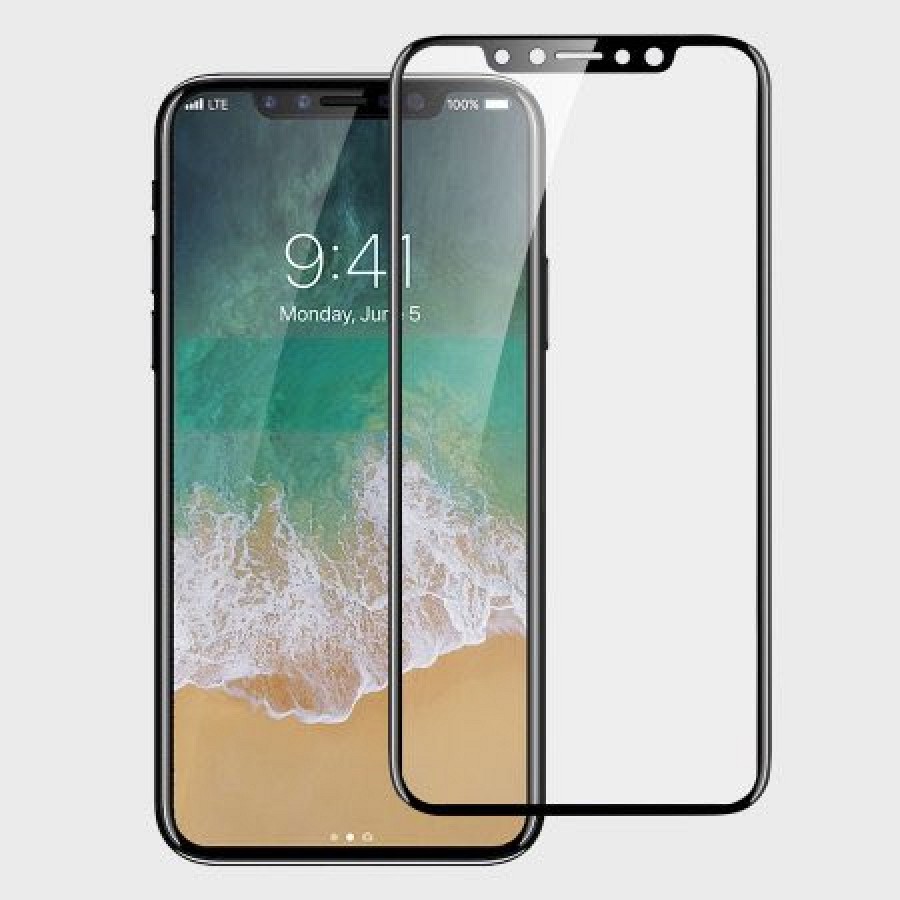
Designed to mirror the look of the iPhone 8, the screen protector features, a 2.5D rounded edge, thin bezels, and a front-facing cutout for the camera, ambient light sensor, proximity sensor, and perhaps other features rumored for the front-facing camera, like a 3D sensing module.
PROTOTYPE 2:
The second distinct design we've been seeing features an almost edge-to-edge display with slim bezels at the top and the bottom, along with a vertical dual camera and a Touch ID fingerprint sensor located at the back of the device. The rendering also suggests the device is 8.6mm thick, a good deal thicker than the 7.1mm iPhone 7.
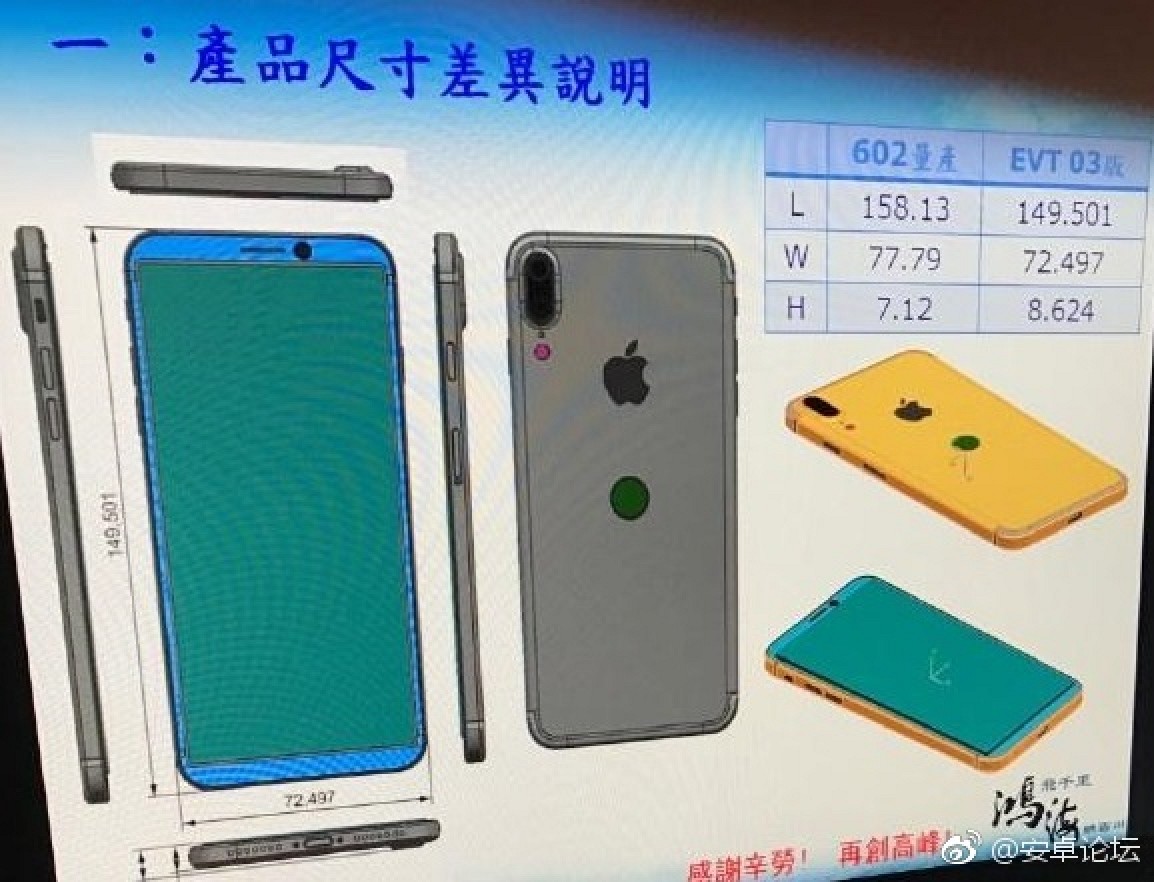
This may have been an early prototype developed because Apple was rumored to he having trouble putting the Touch ID fingerprint sensor under the display of the device, so it's possible the rear Touch ID design was conceived as a backup plan. Should Apple figure out its manufacturing issues or opt to nix Touch ID entirely, this is not the design we'll be seeing in the finalized device.
Another design schematic features a similar build, with an aluminum chassis that's similar to the chassis of the iPhone 7 and a circular cutout that could potentially be for a Touch ID fingerprint sensor or a contact-based wireless charging module.
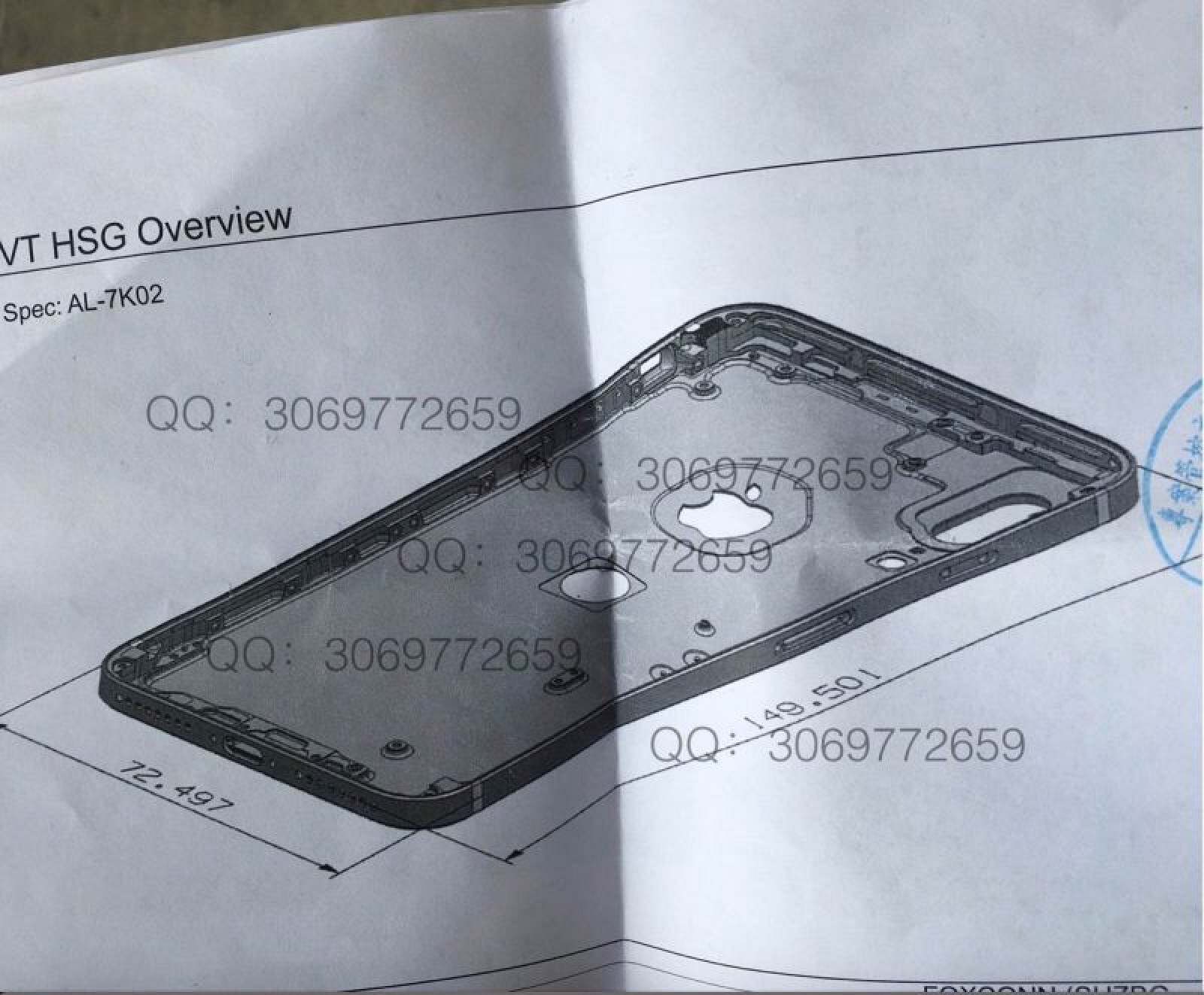
According to the schematic, the device measures in at 149.5mm tall and 72.5mm wide, slightly larger than the 4.7-inch iPhone 7, which measures in at 138.3mm by 67.1mm. A render of a full rear shellbased on the design leaks gives a better idea of what the aluminum iPhone prototype might look like should Apple choose a rear Touch ID design. It depicts a dual vertical rear camera and a cutout, likely for a Touch ID fingerprint sensor.
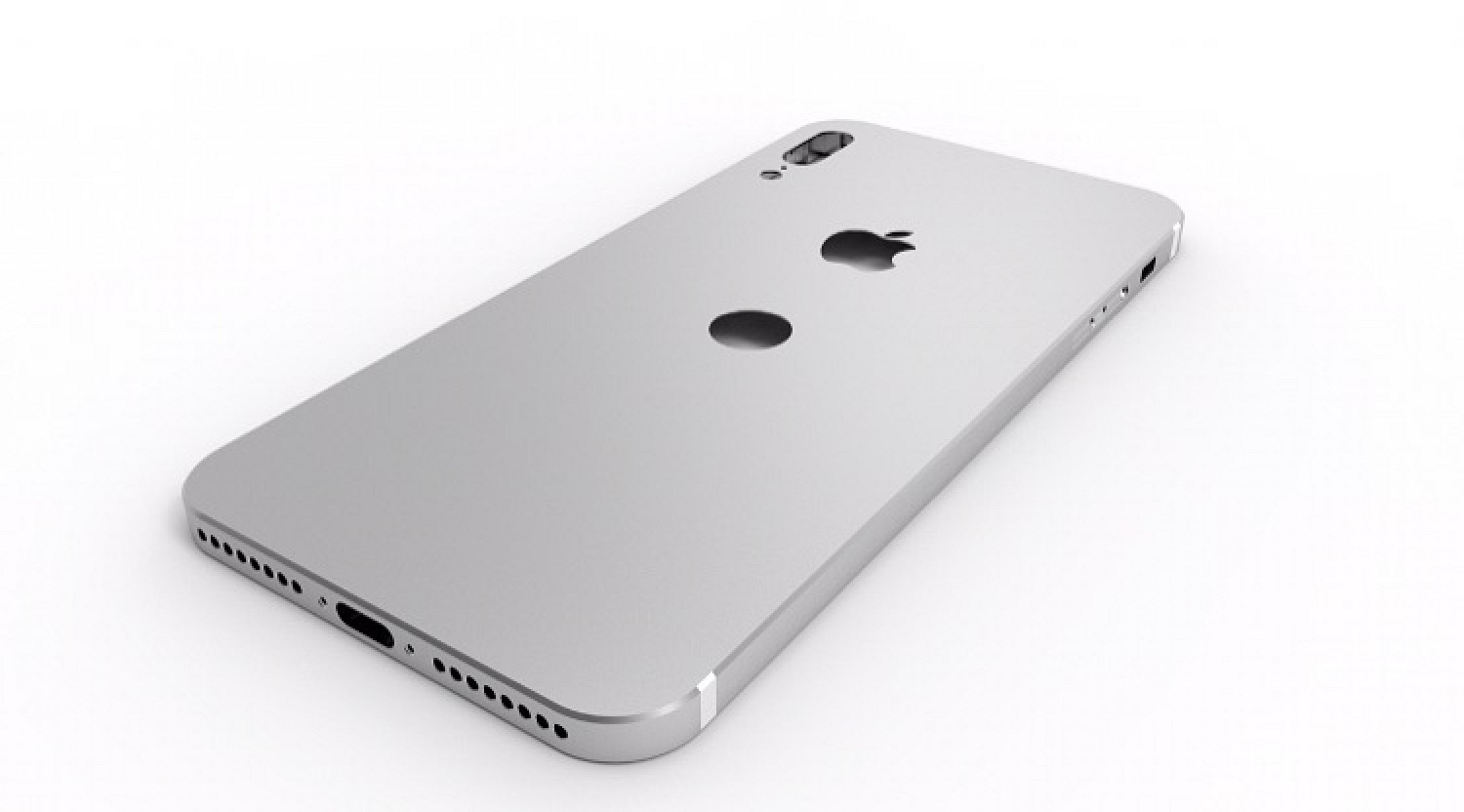
Given the mixed information, it's not yet clear which of the devices pictured above is what we'll see in the fall, but it rumors seem to be coalescing around the first design with Touch ID either built into the display or eliminated, meaning we won't have a physical button for Touch ID. Apple's design plans should become clearer as a release date approaches and we see more design details and part leaks.
Naming
Following Apple's standard naming scheme, with a numeric increase during even years to mark external design changes and an "S" increase during odd years to denote internal feature updates only, the 2017 iPhone would be called the "iPhone 7s."
Given the major changes Apple plans to introduce to the iPhone in 2017, it seems unlikely the device will receive an "S" name, so there's a good chance Apple may decide to skip directly to the next full number, naming the 2017 iPhone the iPhone 8.
2007 - iPhone
2008 - iPhone 3G
2009 - iPhone 3GS
2010 - iPhone 4 (new design)
2011 - iPhone 4s
2012 - iPhone 5 (new design)
2013 - iPhone 5s
2014 - iPhone 6 and iPhone 6 Plus (new design)
2015 - iPhone 6s and iPhone 6s Plus
2016 - iPhone 7 and iPhone 7 Plus
2017 - iPhone 8 and iPhone 8 Plus
2008 - iPhone 3G
2009 - iPhone 3GS
2010 - iPhone 4 (new design)
2011 - iPhone 4s
2012 - iPhone 5 (new design)
2013 - iPhone 5s
2014 - iPhone 6 and iPhone 6 Plus (new design)
2015 - iPhone 6s and iPhone 6s Plus
2016 - iPhone 7 and iPhone 7 Plus
2017 - iPhone 8 and iPhone 8 Plus
iPhone 8 is a tentative name for the device -- it has not yet been confirmed by Apple -- but it seems to be the most logical choice for a major update. There's always the possibility Apple will call it something else or make 2017 the year it moves away from a numbered iPhone naming scheme.
Work on the 2017 iPhone is said to be taking place in Israel, and one report suggests employees at the facility are calling the device "iPhone 8," but it continues to be unclear as to whether that's the official name Apple will go with.
Apple is planning to produce a total of three iPhone models in 2017, further confusing the potential naming scheme. As two these devices could perhaps be similar in style to the existing iPhone 7 and iPhone 7 Plus, sold alongside the flagship OLED model, some rumors suggest they could be called the "iPhone 7s" and an "iPhone 7s Plus." In that case, we'd have an iPhone 7s, and iPhone 7s Plus, and an iPhone 8 or some other name like iPhone X or iPhone Pro.
Japanese site Mac Otakara believes the iPhone 8 might actually be called the "iPhone Edition," after the higher-end Apple Watch Edition models. Such a name would reportedly reinforce its position as a high end iPhone that's meant to be sold alongside two standard iPhone models.
Design
For the iPhone 8, Apple is planning to move away from the aluminum body that it's been using since 2012 in an effort to differentiate the new iPhone from the devices that have come before it. Apple is expected to instead re-adopt the glass-backed body last used for the iPhone 4s. Glass is more fragile and heavier than aluminum, but many advances have been made in glass technology and materials like Gorilla Glass are sturdier than ever, which may help prevent breakage.
Multiple rumors have suggested there will be three versions of the iPhone: a "premium" OLED model and two standard LCD devices, with sizes that may include 4.7, 5.8 inches (OLED), and 5.5 inches. While one model (the high-end OLED device) will feature a glass body, rumors disagree on what the other two models will be made from.
According to KGI Securities analyst Ming-Chi Kuo, who has shared several accurate rumors about Apple's design plans in the past, all three iPhones will feature the same glass-bodied design, with glass instead of aluminum used for the body of the device. Kuo also believes a stainless steel frame will be used in the higher-end iPhone, while less expensive models may get an aluminum frame. Bloomberg, a site that often has knowledge of Apple's plans, has confirmed Apple's plans to use steel-framed glass for the OLED iPhone.

Japanese site Nikkei also believes Apple will use glass for all three of the iPhones that are in development, but other sources have suggested only one -- the OLED model -- will have a glass body, while others continue to use an aluminum body.
The CEO of Apple supplier Catcher Technology, Allen Horng, has said "only one model" will adopt a glass casing in 2017, suggesting other non-glass iPhones are in the works, but Apple supplier Wistron has implied all three will feature wireless charging, necessitating glass bodies. Japanese site Mac Otakara has suggested Apple will sell a 4.7 and 5.5-inch aluminum "iPhone 7s" and "iPhone 7 Plus" with a design that's largely unchanged from the iPhone 7 with the exception of a new red color option, and DigiTimespredicts a 4.7-inch "iPhone 7s" with an aluminum body to be sold alongside a 5.8-inch OLED iPhone with a glass body and a 5.5-inch model of an unspecified material.
There are two possible outcomes based on the rumors we're hearing: Either we get three iPhones with glass bodies and wireless charging, with extra features to set the OLED model apart from the standard models, or we get a single OLED model with a glass body sold alongside two standard aluminum devices, which may or may not have wireless charging.

Size wise, while the OLED iPhone will use a larger display panel because it includes no bezels, it may be similar in size to the 4.7-inch iPhone, so it's reasonable to picture the iPhone 8 as an iPhone 7 with a screen that spans from edge to edge. The device is said to be in a limited number of colors given the fact that it will be marketed as a "premium" version of the iPhone.
Rumors suggest the iPhone 8 may perhaps come in four colors, with one of the colors being a "mirror-like" shade that's more reflective than previous-generation models. The iPhone 8 may only come in shades of black, as only black front panels have been spotted in the supply chain. That means there would be no white variant.
Korean site ETNews said the OLED iPhone 8 could potentially use a design that pays homage to the original iPhone, with deep rear curves and a "water drop" shape. The site says the device features a curved glass body that is both gentler and rounder than the design of the existing iPhone 7, similar to the first iPhones that were made, but based on information from Bloomberg, that particular design may have been scrapped in favor of a simpler design.
According to Bloomberg, Apple's latest prototype design features symmetrical, slightly curved glass on the front and back of the iPhone. The curves are similar in shape to the iPhone 7, with a flat OLED screen and a cover glass that curves into a steel frame. Conceptually, it's said to be similar to the 2010 iPhone 4, and this is the design we've seen most often in leaked schematics, dummy units, and renderings.
Apple tested a design with a thinner steel band and more noticeable curved glass, along with a glass back that had dramatic curves, but because Apple suppliers struggle to produce glass with significant curvature in mass quantities, Apple is said to be more likely to use a simpler design. The company is also testing a design with an aluminum back.
We've also seen some design schematics and renderings suggesting Apple could potentially put Touch ID on the back of the iPhone, should plans to put it under the display fall through. Apple is said to be struggling with putting Touch ID under the display, but recent information sourced from Apple supplier TSMC suggests those problems have been worked out.

WATER RESISTANCE
The iPhone 8 may feature an IP68 water resistance rating, an improvement over the IP67 certification earned by the iPhone 7 and the iPhone 7 Plus. Like the Galaxy S7, which is also IP68 certified, the iPhone 8 might be able to withstand 1.5 meters of water for up to 30 minutes while also offering full dust protection.
That means it will continue to hold up to splashes and brief immersion in water, but customers should still make an effort to avoid water as Apple's iPhone 7 warranty does not cover water damage and it's likely the iPhone 8 warranty will also exclude water damage.
Apple supplier Wistron accidentally leaked information on the iPhone's water resistance. In an interview, a Wistron executive implied that at least one iPhone model would be "waterproof" and would support wireless charging. Because Wistron is manufacturing the 5.5-inch iPhone 7s Plus rather than the iPhone 8, the exec was likely referring to the iPhone 7 Plus, but a feature coming to the iPhone 7 Plus will undoubtedly extend to the other two iPhone models expected in 2017.
Facial Recognition vs. Touch ID
According to KGI Securities analyst Ming-Chi Kuo, Apple is planning on eliminating Touch ID entirely in the iPhone 8 and replacing it with a new security system that's based on facial recognition. Facial recognition capabilities powered by new 3D sensors have long been rumored for the iPhone 8, but it wasn't suggested until recently that the functionality would replace Touch ID entirely.
Kuo's prediction has been echoed by JP Morgan analyst Rod Hall and Bloomberg, with the site suggesting Apple will introduce an "improved" security system that will let customers unlock their iPhones and make Apple Pay payments with facial recognition instead of a Touch ID fingerprint sensor. Apple's 3D sensing facial recognition system is advanced and can unlock an iPhone within a few hundred milliseconds.

It's said to work even when an iPhone is set on a table, so it's functional from many different angles and should not be a hassle to use even when making payments at a terminal. It captures more data points than a fingerprint scan, so it's more secure than Touch ID. Apple is also using 3D depth perception techniques that will prevent the facial recognition from being fooled by a photograph.
Iris scanning is also a possibility that Apple is testing to augment its facial recognition, and both technologies will be enabled through a more advanced front-facing camera system with 3D sensing functionality. Apple is said to be using a high pixel density front-facing camera and other advanced sensors.

Original rumors suggested Apple was planning to integrate Touch ID into the display of the device, but that functionality may not have panned out due to production difficulties and other issues with the technology.
Some rumors say Apple is still trying to decide on a course of action, but at this late date, it's likely a decision has been made. Rumors persist, though, a and Fast Company source says Apple is still working to implement Touch ID under the device's display, and that its inclusion in the iPhone 8 is "likely." There's said to be a "sense of panic" in the air as Apple designers and engineers work to overcome software problems with Touch ID, the 3D sensor, and wireless charging.
There was some speculation that Touch ID could potentially be built into the elongated button that's included in the iPhone 8, but supply chain sources say the button is solid with no additional sensors or components that would be required for Touch ID. For that reason, Touch ID is also not likely to be built into the power button.
Due to the different rumors and the fact that the facial recognition system is allegedly "still being tested," it continues to be unclear if the iPhone 8 will indeed do away with Touch ID entirely in favor of facial recognition. There have been multiple rumors about under-display Touch ID, including some pointing towards specific component suppliers, so we'll need to wait for more information to confirm Apple's iPhone 8 plans.
Regardless of whether the iPhone 8 has Touch ID, the two devices that will be sold alongside it, the "iPhone 7s" and the "iPhone 7s Plus," are expected to continue to offer Touch ID Home buttons.
Display
At least one iPhone 8 model is expected to include a flexible OLED display and Apple has already signed a deal with Samsung to produce OLED displays for devices set to debut in 2017.
An OLED display eliminates the need for the backlighting that's used in traditional LCDs, which would allow Apple to cut down on the thickness and weight of the display used in the device. OLED displays can also be flexible, but Apple is planning to use a flat 2.5D display in the iPhone 8.
OLED displays offer better contrast ratio, truer colors, improved viewing angles, better power efficiency to maximize battery life, and a faster response time than an LCD for faster refresh rates. On the downside, OLED displays don't have the lifespan of an LCD display and they're more prone to water damage, two issues Apple will need to overcome. Apple already uses OLED displays in the Apple Watch.

There are multiple rumors about the size and type of the panels Apple will be using, and rumors indicate Apple is testing more than 10 iPhone prototypes. While we've heard several rumors pointing towards different display sizes, information seems to be solidifying around a screen size of 5.8 inches, with a smaller active display area.
Because Apple has tested so many design prototypes for the iPhone 8, we've heard a lot of mixed information on the design of the display. On the whole, it's sounding like the display will likely be somewhat curved (similar to the existing iPhone 7) with a very small bezel in the range of a few millimeters.
Multiple rumors suggest Apple will implement an edge-to-edge display, which means the iPhone will have very thin top, bottom, and side bezels, with the display taking up the entire front of the device. It will look like a single, uninterrupted piece of glass.
According to KGI Securities analyst Ming-Chi Kuo, the iPhone 8 is said to have the "highest screen-to-body ratio of any smartphone currently available worldwide" due to the edge-to-edge display and the ultra-thin bezels. A "notch" for the front-facing camera and its accompanying sensors is said to be the only noticeable part of the iPhone 8's bezel. Sensors like Touch ID will be embedded in the display or eliminated, and there will be no iconic Home button on the device.
Kuo believes the OLED iPhone 8 will feature a 5.8-inch display, but it will only have 5.15 inches of active screen space. Additional screen space is said to be taken up by virtual buttons that replace the current physical Home button, a prediction echoed by The Wall Street Journal. Kuo lays out his size predictions in the diagram below:

Based on Kuo's description, the iPhone 8 can be thought of as having a screen the size of the 5.5-inch iPhone in a form factor that's the size of the 4.7-inch iPhone. Imagining an iPhone 7 Plus that features just a display and no bezels is a good way of conceptualizing what the iPhone 8 might look like. The device, as described by Kuo, has a resolution of 1125 x 2436.
With the edge-to-edge display, KGI Securities analyst Ming-Chi Kuo believes Apple will continue to use a 2.5D display, like the display in the iPhone 7. Japanese site Nikkei has echoed Kuo's prediction and also expects Apple to use a 5.8-inch display.
Most rumors point towards a 2.5D display for the iPhone 8, but there have been some outliers and some confusing rumors based on the different way curved displays are described. Nikkei Asian Review, for example, says the iPhone 8 will feature a curved OLED display, but with a gentler curvature than the Samsung Galaxy S7 Edge. Technically, that sounds similar to what other sources have described -- a curve like the slight curve of the existing iPhone 7.
The site does, however, say that Apple "would not be using OLED optimally" if it implemented a display like existing models, but Nikkei appears to expect a display that is slightly curved beneath the edges of the 2.5D cover glass, a curve not nearly as significant as the curve on the Galaxy S7. Nikkei, like Kuo, expects the curved screen to allow for a viewable area of 5.2 inches. The Wall Street Journal also suggests a curved display, but does not go into detail on what that means.
It sounds like a lot of the display rumors are saying the same thing, though it can seem quite different due to the confusion over and the different interpretation of the word curve. Based on what we're hearing, we expect an OLED iPhone 8 with a display that's just slightly curved downwards at the edges but mostly flat.
According to information said to be shared by a source at Apple supplier TSMC, the iPhone 8 will feature a 18.5:9 aspect ratio instead of a 16:9 aspect ratio. That's the same aspect ratio the Galaxy S8 and S8 Plus use.
MacRumors has been receiving visits from devices with a display resolution of 375 x 812, which translates to 1125 x 2436 using pixel tripling, suggesting Kuo's resolution prediction may be accurate. The devices appear do not correspond to any known devices and are believed to be iPhone 8 models.
As previously mentioned, Apple is rumored to be planning on debuting three devices, one premium model with an OLED display and two standard models that use traditional LCD panels. While there is confusion over the size and curvature of the OLED panel, the LCD iPhones are expected to be 4.7 and 5.5 inches, the same size (and design) as the iPhone 7 and iPhone 7 Plus.
All three of the iPhone models set to be released in 2017 could include True Tone displays, according to Barclays analysts. A "full spectral sensing" ambient light sensor will enable "True Tone" colors that will adjust the display to the light in its surrounding environment. The current-generation iPad Pro was the first device to include a True Tone display, an example of which is below.

In a room with fluorescent lights, for example, the iPhone's display might appear more blue, while in a room with warmer incandescent lights, the display would appear slightly more yellow. At least one device is also expected to include ProMotion display technology, which supports a 120Hz refresh rate for improvements to motion and animations. ProMotion was first introduced in the 2017 iPad Pro models.
Processor
All iPhone models coming in 2017 are expected to use Apple's A11 chip, including the OLED iPhone 8 and the more modest 4.7 and 5.5-inch iPhones (which could be called the iPhone 7s and the iPhone 7s Plus).
TSMC began production on Apple's A11 processor in May 2017. TSMC initially wanted to start productionin April, but production was reportedly delayed due to issues with the 10-nanometer FinFET manufacturing process. The A11 chip is expected to be both faster and more power efficient than the current A10, manufactured on a 16-nanometer process. It could introduce speedier performance and better battery life.
Wireless Charging
Early iPhone 8 rumors suggested Apple was working on long-range wireless charging technology that could be implemented as soon as 2017, but more recent information and speculation suggests that instead of long-range wireless charging techniques, Apple will instead use an inductive-style wireless charging solution (similar to the Apple Watch) for the device, and Apple supplier Wistron has accidentally confirmed that wireless charging is planned for at least one iPhone model.
Apple in February joined the Wireless Power Consortium, which is committed to the open development of the Qi wireless charging standard that's widely used in devices like the Samsung Galaxy line, and Apple has filed dozens of patents for inductive charging. Dozens of hires with expertise in wireless charginghave also joined the company over the past year.
The iPhone 8 is expected to include a WPC-based Qi wireless charging solution that will be enabled through an optional accessory that will be purchased alongside the new iPhones.
Apple is said to be having issues with the software related to the wireless charging functionality, so the inductive charging accessory that will enable the feature may not ship until later in the year, perhaps alongside an iOS 11.1 update.

There's been plenty of evidence that Apple is seeking components for an inductive charging solution. Lite-On Semiconductor is rumored to be providing integrated chip components for the wireless charging module in the iPhone 8. The manufacturer will reportedly supply bridge rectifiers needed to reduce thermal issues and maintain efficiency in wireless power transmission, and Apple is also perhaps sourcing components from MediaTek, Foxconn, Pegatron, and Luxshare. Foxconn and Pegatron are said to be manufacturing the charging bases that will be used with the iPhone.
It's possible Apple originally considered long-range wireless charging techniques but has not yet been able to perfect the solution, which would explain the mixed rumors.
There was speculation suggesting Apple is working with a partner, possibly Energous, a company that's developed a long-range wireless charging solution called WattUp, but there's been no hard evidence. Energous CEO Steve Rizzone has encouraged such rumors claiming the company has inked a deal with "one of the largest consumer electronic companies in the world," but it continues to be unclear if that partner is Apple. If Apple is indeed working on long-range wireless charging, it could be introduced in the future.
Regardless of the wireless charging method used, KGI Securities analyst Ming-Chi Kuo believes that all new iPhones are likely to support wireless charging next year, including the 4.7-inch model, the larger 5.5-inch model, and the high-end OLED model, as does Susquehanna analyst Christopher Rolland.
Other Features
STORAGE
The iPhone 8 is expected to include NAND flash memory from Samsung, but it is not clear what improvements it might bring. With the iPhone 7 and 7 Plus, Apple introduced a 256GB storage option, and it's possible additional increases could be included in the iPhone 8.
One rumor has suggested the iPhone 8 will include increased storage space, which could make the device more expensive than previous-generation iPhone models, and two additional rumors say it will be available in 64 and 256GB capacities.
3D NAND flash chips for the 2017 iPhones will be supplied by SK Hynix, Toshiba, and Samsung.
RAM
Like the iPhone 7 Plus, the iPhone 8 is rumored to include 3GB RAM. The larger iPhone 7s Plus is expected to include 3GB RAM, while the smaller iPhone 7s will continue to offer 2GB RAM. The DRAM transfer speed of the three new models is expected to be faster than the iPhone 7 by 10 to 15 percent for better AR performance.
TAPTIC ENGINE
An enhanced Taptic engine is one of the features that could be included in the 2017 iPhone, according to a report from Japanese site Nikkei. Apple is said to be working on a "high-performance motor" that's able to "create more complex tactile vibrations."
Such an engine would perhaps be necessary if Apple is indeed eliminating the Home button in the iPhone 8, as has been rumored. Haptic feedback could offer vibrations to denote triggers like the unlocking of the iPhone and the confirmation of a Touch ID payment, two features currently tied to the physical iPhone Home button.
3D TOUCH
With Apple implementing glass bodies for the iPhone and introducing at least one OLED display, new 3D Touch technology may be required. According to KGI Securities analyst Ming-Chi Kuo, Apple will need to use a new 3D Touch module with "additional graphite sheet lamination" for heat reduction.
SPEAKER
Kuo also believes the iPhone 8 will feature more consistent output power for the speaker and the receiver to create better stereo effects.
BATTERY LIFE AND CHARGING
We've heard few rumors on the prospective battery life of the iPhone 8, but one rumor from Fast Company says the device will include a "far bigger battery," which could result in improved battery life. A larger battery could also be implemented to power features like an OLED display or new biometric features that are rumored, though, so longer battery life is not a guarantee.
Apple is said to be planning to use a stacked logic board design that will support longer battery life. With the improved logic board, the iPhone 8 will be able to offer the same battery life traditionally available in the 5.5-inch iPhone in a device the size of the 4.7-inch iPhone. An L-shaped two-cell battery pack with a capacity around 2,700 mAh could be included. Battery life could be further improved through the use of a more energy efficient OLED panel.
KGI Securities analyst Ming-Chi Kuo predicts Apple will implement USB Type-C power delivery technology(while still using the Lightning port) to offer a fast charging feature that would allow the iPhone to charge more quickly. He believes that while the iPhone 8 will offer fast charging functionality, it will continue to ship with the same 5W power adapter equipped with a USB-A port that's included with iPhones today. A USB-A to Lightning cable will also be included as a standard accessory.
Barclays analyst Blayne Curtis disagrees with Kuo and predicts the iPhone 8 will ship with a 10W USB-C wall charger, an upgrade from the 5W charger that ships with the current iPhone 7 that would allow the iPhone 8 to charge faster. The 10W power adapter would include a USB-C connector (and a Lightning to USB-C cable) along with an integrated USB-C Power Delivery chip.
REAR CAMERAS
KGI Securities analyst Ming-Chi Kuo believes that the dual-lens camera introduced in the 5.5-inch iPhone 7 Plus will continue to be a feature exclusive to "high-end" iPhone models in 2017.
Kuo predicts a 4.7-inch iPhone with a single camera, a 5.5-inch model with a dual-lens camera, and an OLED model in an unspecified size with a dual-lens camera.
He believes that future models will include optical image stabilization (OIS) for both the wide-angle and telephoto lenses. In the iPhone 7 Plus, only the wide-angle lens features OIS. The camera in the 2017 iPhone could also support 3D photography effects if Apple opts to use an LG camera module.
According to Japanese site Mac Otakara and multiple design leaks, the high-end 5-inch iPhone Apple plans on will adopt a new vertical dual camera arrangement instead of a horizontal dual camera system. A vertical dual camera has also been seen on alleged iPhone 8 design schematics and has been confirmed by Bloomberg.
According to Fast Company, Apple is working on a rear-facing VCSEL (vertical-cavity surface-emitting laser) system that could be included in the iPhone 8. Such a system would offer faster and more accurate depth measurements for augmented reality purposes, along with speedier autofocusing when taking a photograph.
Fast Company said it's not sure the camera system will make it into the iPhone 8, but given past rumors of of a 3D system and the vertical dual-lens camera redesign, it seems likely Apple has something big planned for the iPhone 8's rear camera.
FRONT-FACING CAMERA
Apple is working on a major revamp of its front-facing camera in the iPhone 8, adding 3D sensing capabilities for facial recognition. The camera, which KGI Securities analyst Ming-Chi Kuo has called "revolutionary," is said to consist of three modules: a standard camera front-facing camera module, an infrared transmitting module, and an infrared receiving module, all of which will allow the iPhone 8 to perform 3D sensing and modeling.
The infrared (IR) transmitter and receiver will work together to project invisible light into a room or a scene, casting points of light on all of the objects in an area. The infrared patterns and signals are read by the iPhone and allow it to capture depth information, which is paired with 2D images taken with the standard camera.
The data captured by the iPhone is analyzed with algorithms Apple acquired in 2013 from PrimeSense, and it's this technology that will enable the iPhone to analyze a person's facial structure for facial recognition or detect the layout of a room. The front-facing camera system will be integral for facial recognition, a feature that could potentially replace Touch ID in the iPhone 8, and it also has augmented reality applications.
Apple is said to be sourcing components for the front-facing camera from LG, and it some parts may also be coming from Largan Precision, which has said it plans to ship lenses for 3D sensing modules in the second half of 2017, along with Lumentum and Finisar.
SIRI
The iPhone 8 may feature enhanced Siri functionality according to a rumor from DigiTimes. It's not clear what an enhanced version of Siri would be able to do, but it could include an overall refinement to the personal assistant's ability to respond to contextual requests and other dialogue.
Apple is said to be taking advantage of technology it acquired when it purchased AI startup Turi in August of 2016. It's not clear if improved Siri capabilities will be introduced in iOS 11 and available for multiple devices or tied specifically to the iPhone 8
Release Date
For the last several years, Apple has released its iPhone updates in September, so we expect to see the the new lineup unveiled in September of 2017, but there have been many rumors pointing towards launch delays and supply shortages.
Apple is said to be having some technical difficulties with the display lamination process and other high-tech components like the 3D sensor, leading to multiple rumors pointing towards a launch date that could potentially be delayed into October or November. Apple could be planning to introduce the device in September and then hold off on shipping it until later in the year, or it could be available in very limited quantities until Apple can ramp up production. Most rumors pertain to the iPhone 8, but we've also heard that all three of the devices Apple plans to launch could see delays.
- Get link
- X
- Other Apps
Comments
Post a Comment